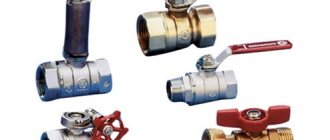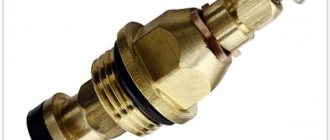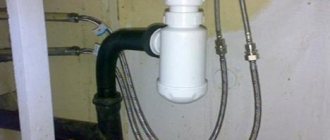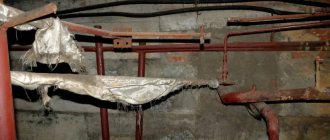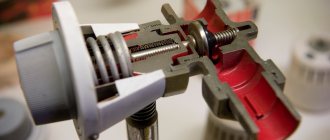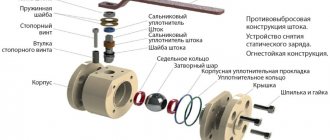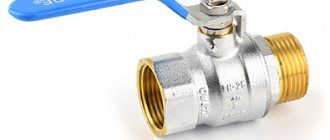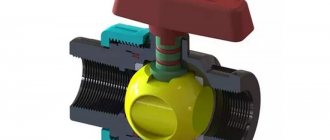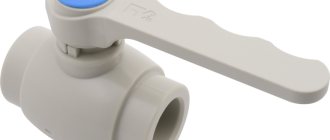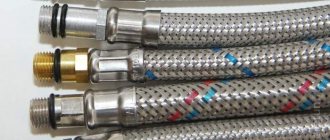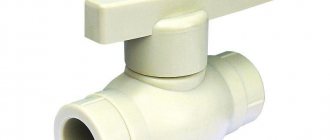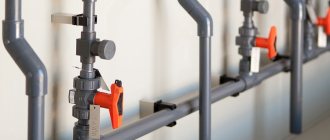What to do if the fluid leaks
The problem of faulty plumbing worries many; even on the Internet you can often find queries on this topic, for example, “faucet is leaking, how to fix it, video.” Meanwhile, most faults are easily fixed.
Currently, the most common are single-lever faucets with a cartridge (faucet axle box). Both hot and cold water in such a mixer are turned on by lifting a single lever. Most often, incorrect operation of faucets of this type is caused by a cartridge that has become unusable. In this case, you just need to replace the cartridge with a new one. For repairs, you will need a small flathead screwdriver, an adjustable plumber's wrench and a new cartridge.
The faucet is leaking in the bathroom or kitchen. Procedure:
- Turn off hot and cold water.
- Remove the upper part of the lever-handle.
- If there is a protective clip blocking access to the screw, remove it.
- Use a screwdriver to unscrew the screw.
- Now carefully remove the lever and unscrew the decorative cover covering the cartridge nut.
- Using an adjustable wrench or a suitable wrench, unscrew the nut and remove the cartridge by hand.
- Insert a new cartridge and repeat all steps in reverse order.
- All that remains is to restore the water supply and check the operation of the tap.
How to shut off a heating riser
The heating riser belongs to common property. It must be blocked by employees of the service organization who have the right to do so.
If you follow the letter of the law, you must come to the DEZ, Housing Office, DEU, etc. write an application, pay for the service at the cashier. At a certain time (indicate in the application) a representative of the service organization must come and turn off the valve in the basement.
How much does it cost to turn off the heating riser? This is not an easy question. The fact is that there are no fixed prices. There is a price list for services, but it is only a recommendation. In reality, each organization sets its own prices. On average, you will have to pay from $15 to $20 for this operation.
The valve that shuts off the heating supply is located in the basement of the house
There is a workaround. Agree with neighbors and shut off the riser yourself without the campaign’s knowledge. But you know that this is not always possible: neighbors are different. If in the summer, when the heating is turned off, such actions may meet with understanding, then during the season - it is unlikely. There is another difficulty: the heating valve is not always easy to find. You either need to have a communication scheme, or just know where it is. They usually know a locksmith. But they won’t block the riser for free, and will require at least $10-15. There seem to be savings, but they are small. And if this fact becomes known to the management or operational company, you will face substantial fines.
Manufacturer Ariston
How to turn on the Ariston boiler? First of all, you will need to fill the boiler with water and connect the device to the power supply. Within the first couple of minutes, the indicator panel will start working. At the moment, your boiler is not yet turned on, as indicated by flashing temperature indicators.
In order for the device to start working, press the “turn on” button; on the display you will see the current water temperature in the tank. In order to select the temperature you need, press the “+” or “-” buttons; by pressing any of these keys, you will switch to the temperature selection mode. The temperature is available in the range from 35 to 70 degrees.
The manufacturer also equipped its models with the ability to change the available power: 1500 or 2500 W. You can activate this setting by pressing the “power” button for a couple of seconds. The boiler does not have a memory function, so when it is turned off, the settings will be reset.
The Ariston mechanical model has even more simplified controls. After you have connected the boiler to the power supply, press the “turn on” button - it will light up red. As soon as the water reaches the desired temperature, the power button will go out.
The power of the mechanical model can also be increased. Its main feature is that while the water heater is operating, the red shutdown button lights up. As soon as the device stops working, the button goes off. This immediately lets us know that the water is ready for use.
Types of valves
To determine the position of the device and find out how the valve opens or closes, you first need to know the type of device installed.
In household systems the following are most often installed:
ball valves. There is a metal ball in the body of the device, which serves as a locking mechanism. The body and locking element are usually made of durable metals (brass, steel, bronze), which ensures a long period of use of the device;
Valve with ball-shaped locking mechanism
plug valves. The locking elements in this type of device are cylindrical or conical plugs. The plug valve body is also made of high-strength metal. The locking mechanism allows the valve to be used in pipelines with aggressive media.
Valve with cylindrical plug
In most cases, ball valves are installed on heating and water supply systems, and plug valves on gas pipelines.
Guys, how to open the Mayevsky tap? No matter which way I turn it, it’s useless. no air, no water.
It is not the tap itself that needs to be turned, but the cog in the tap. Counterclockwise - opening. Clockwise - closing. It is useless to turn the tap itself. It just rotates and that's it.
Yes it should open easily. Take a screwdriver and find the screw in the middle
Place a screwdriver in the special thread on the faucet and slowly turn it counterclockwise. If you hear a hiss of air escaping from the radiator pipe, stop rotating. The air will rush into the apartment with a loud sound, the main thing here is not to lose composure. When water starts pouring out of the tap instead of air, immediately turn it in the opposite direction, i.e. clockwise. More details: https://www.happy-giraffe.ru/community/26/forum/post/49806/
All that remains is to see if the supply valve and return valve are open.
Ball valve design
Ball valve design
The ball valve body can be made of brass, silumin (an alloy of aluminum and silicon) or ZAMAK (zinc alloy). The ball mechanism is sealed with fluoroplastic rings.
Silumin alloy and TsAM are quite fragile and taps made from these alloys do not work for a long time. These faucets are mostly white. But brass taps coated with chrome can also be white.
Some features of popular systems
In order to somehow highlight their protection against water leaks, manufacturers are trying to improve reliability or come up with other moves. It is impossible to systematize these features, but it is better to know about them when choosing.
Capabilities of one block
For different manufacturers, one control unit can control a different number of devices. So it won't hurt to know this.
- One Hydrolock controller can service a large number of wired or wireless sensors (200 and 100 pieces, respectively) and up to 20 ball valves. This is great - at any time you can install additional sensors or install several more cranes, but such a reserve of capacity is not always in demand.
- One Akastorozh controller can service up to 12 wired sensors. To connect wireless, you need to install an additional unit (designed for 8 Aquawatch Radio pieces). To increase the number of wired ones, install another module. This modular expansion is more pragmatic.
- Neptune has control units of different powers. The most inexpensive and simple ones are designed for 2 or 4 taps, for 5 or 10 wired sensors. But they do not check the functionality of the taps and do not have a backup power source.
As you can see, everyone's approach is different. And these are just the leaders. There are even smaller campaigns and Chinese companies (where would we be without them) that either repeat one of the above plans or combine several.
Additional functions
Additional ones are not always unnecessary. For example, for those who are often on the road, the ability to control cranes from a distance is far from superfluous.
- Gidrolok and Akvatorozh have the ability to turn off water remotely. For this purpose, a special button is placed at the front door. Go out for a long time - press and turn off the water. Aquawatch has such a button in two versions: radio and wired. Gidrolok has only wired ones. The Aquastore radio button can be used to determine the “visibility” of the wireless sensor installation location.
- Hydrolock, Akvastorozh and some Neptune variants can send signals to the dispatch service, security and fire alarm systems, and can be built into the “smart home” system.
- Hydrolock and Akvastorozh check the integrity of the wiring to the taps and their position (some systems, not all). In Hydrolock, the position of the locking ball is controlled by an optical sensor. That is, when checking there is no voltage in the tap. The Aqua Watchman has a contact pair, that is, at the time of testing, voltage is present. Protection against water leaks Neptune also monitors the position of the taps using a contact pair.
The hydrolock can be controlled using a GSM module - via SMS (commands to turn on and off). Also, in the form of text messages, signals about accidents and “disappearances” of sensors, broken cables to electric taps and malfunctions can be sent to the phone.
Always being aware of the condition of your home is a useful option.
On the issue of reliability: power supply and other issues
Reliable operation does not only depend on the reliability of the cranes and controllers. Much depends on the power supply, on how long each unit can operate autonomously.
- Aquawatch and Hydrolock have backup power sources. Both systems shut off the water before the backup power supply is completely discharged. Neptune has batteries only for the last two models of controllers, and then the taps do not close when discharged. The rest - earlier and less expensive models - have a 220 V power supply and no protection.
- Neptune's wireless sensors operate at a frequency of 433 kHz. It happens that the control unit “does not see” them through the partitions.
- If the batteries in the Gidroloka wireless sensor run out, the alarm on the controller lights up, but the taps do not close. The signal is generated several weeks before the battery is completely discharged, so there is time to change it. In a similar situation, the Aqua Watchman shuts off the water. By the way, the Hydrolock battery is soldered. So changing it is not so easy.
- Aquawatch has a lifetime warranty on any sensors.
- Neptune has wired sensors that are installed flush with the finishing material.
We looked at all the features of the three most popular manufacturers of water leakage protection systems. In short, the worst thing about the Aquawatch is the plastic gearbox on the drive; the worst thing about the Hydrolock is the high power of the system and, accordingly, the price. Neptune - inexpensive systems are powered by 220 V, do not have a backup power source and do not check the functionality of the taps.
Naturally, there are Chinese leakage protection systems, but you should choose them with caution. https://www.youtube.com/embed/EW3HuvRojwA
Eliminating whistling, humming and noise
In addition to a banal leak, the following problems are quite common: the tap turns; weak water pressure in one of the taps; noises that appear when the water is turned on.
First, let's figure out why the faucet whistles (or hums). Noises can be caused by a worn gasket on the faucet valve or a poor-quality cartridge on the mixer. Change the gasket to a new one (made of thick rubber) or a low-quality faucet axle box to a ceramic product from a reliable manufacturer and the whistle when turning on the water will disappear.
What to do if the water from one tap flows in a weak stream? Presumably, the problem can be caused by a clogged coarse filter installed on the mixer or tap. It is enough to clean and rinse the filter and the water pressure will be restored. The reason may be even more trivial - a clogged mesh on the faucet tap; it can be easily unscrewed and washed.
Valves rotate due to worn threads or a leaky gasket on the valve head. This happens due to torn or worn threads. To eliminate the problem, replace the valve with a new one. If the thread is in order (this can be seen during disassembly), simply change the gasket.
I can’t turn off the water, not a single tap is turning?
These polypropylene taps, just like metal taps, will turn sour if left untouched for years. Remove the plastic lever and carefully turn it with an adjustable wrench (back and forth, little by little developing the amplitude of rotation). There is no one to blame here: the master should have warned you about the need to turn all the taps once every 2 months, and you had to comply (at least once every 1/2 year.
Call the management company
Before the plumber arrives, you can climb into the side of the toilet and raise the float so that water does not collect. Do you turn the tap in that direction?
Call a plumber, let him take a look, if you can’t determine what’s wrong, don’t risk it
You may be twisting it in the wrong direction and you have to put in a lot of effort to get it moving. You need to close it clockwise. “Red” is already blocked for you
It is necessary to turn the taps from time to time. Cranes tend to “stick” to rubbing surfaces. Otherwise, call a plumber, the taps are unreliable and won’t break for long.. (
And you turn the gray tap in the wrong direction. These are both ball valves, they only have two positions, open and closed.
Call the plumbers. The taps are just replacements. Even if you manage to “stir” them without visible losses, the ball seal will be damaged to some extent and the reliability of operation will decrease. These are ball valves. What happened to you is a common thing if they are left untouched for years or used to regulate pressure. According to the documentation, these only have 2 working positions, open and closed, and once a month they must be transferred from one position to another. Otherwise, deposits of salts and water contaminants settling on the surface turn to stone and... which is what happened.
Your taps are stuck. I advise you not to suffer, but to call a plumber and change them so that there are no such problems in the future. And change to better ball valves. For example, RB has high-quality Italian taps; they do not turn sour and turn easily without effort.
Choosing a new water supply valve
Once you answer the question, “What is a shut-off valve? second question ''what valve do I need?'' The best types of quarter-turn shut-off valves are if you have a plumbing emergency (such as a flood), you can shut off your water supply quickly and easily. In addition to being a quarter turn valve, it should fit the type of pipes you have and connect easily to the supply line while having the outlet connection in the correct direction.
If you have metal pipes, you can use a compression valve that will connect to the pipe with a brass end and nut. It can be installed with some pliers and a wrench, so is usually an easier option than having to solder to yours.
A pinch valve may be a little more expensive, but it is also easier to install. They fit every type of pipe and do not require any tools for installation. As the name suggests, the push valve presses on the end of the pipe and the built-in gasket presses tightly against the pipe to hold it in place. They are only slightly more complex to remove than to install, and require less additional space between the valve and the wall than a compression valve.
The layout of your water pipes and your fixture will tell you whether you need a valve with the inlet and outlet connections in a straight line or at a 90 degree angle from one to the other. If you are installing it for a kitchen sink, then you can purchase a three-way valve that has outlets to your kitchen sink and your dishwasher.
Who should turn off the water - yourself or a plumber
It is possible to shut off the water supply to only one apartment if the bathroom has the appropriate fittings. This shutdown technique is suitable for minor repairs, such as replacing a faucet. Such taps can be located in the bathroom or kitchen, in residential buildings built in recent years. In addition, some homes have sensors on the pipes with an automatic mechanism that is triggered when a problem occurs.
If it is necessary to replace larger plumbing equipment (toilet, bathtub), the homeowner turns off the water along the entire water riser.
Thus, the supply will be cut off for several homeowners. To shut off the resource, you need to turn the valve clockwise until it stops.
But if the apartment building is old, then there may be no taps in the bathroom. Then you need to call a plumber from the management company. In this case, the water will be shut off not in one apartment, but in the entire entrance.
If there is a break in the main water supply, the supply may be cut off in the entire house or in several buildings at once.
